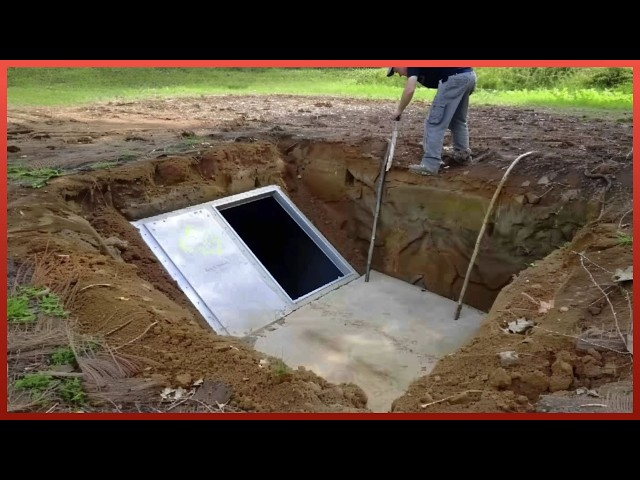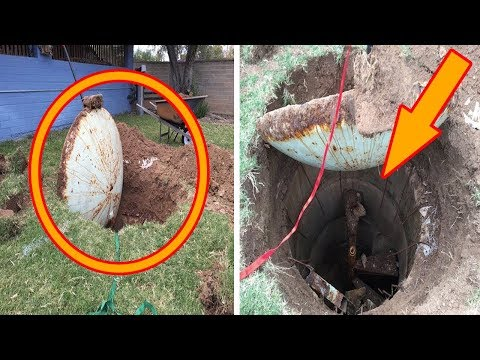John Sims moved to Tucson, Arizona in an attempt to lead a quieter life. He never imagined that it would turn into one of the most memorable experiences of his life. It all started when he was informed of a disturbing rumor by the previous owner of his new home.
It was rumored that something was buried in the ground. John started digging in the backyard because he couldn’t get the thought out of his head. He was shaken by what he found. No doubt he didn’t sign up for it.
The house with the mysterious backyard
John Sims wanted to get a house in downtown Tucson, Arizona after hearing about a friend’s sale. He knew he would be in good hands because the owner was one of his friends. However, after completing the paperwork, his acquaintance informed him of a property rumor.
The older cities say they think there was something interesting hidden somewhere in it. John could solve the puzzle, but his companion never was. In the end, John finds something that would make people all over the state of Arizona very excited. His curiosity got the better of him.
John found himself remembering what his friend had said as he began to set things up in his new home. He was interested as well as curious. He soon became committed to discovering the mysteries surrounding his new home.
John dug and continued to survey his property. After digging up the backyard in four separate locations, John was unable to find anything. Whatever it is, it must be under the bricks if he couldn’t discover it under the grass.
X indicates location

When John gained access to local records, he discovered documentation of the construction of his house. It turns out that a strange building called Whitaker Pools was built in 1961. With confirmation that there is indeed something buried in the ground, John is even more driven to unravel the mystery.
He employed an advisor operating a metal detector to help him pinpoint the location. After arriving with the necessary equipment, the team searched John’s backyard. Soon the metal detectors began to sound. John put a large X in chalk at the locations of the two metal detector triggers.
strike a string
After dismissing the consultants, John eagerly picked up the shovel and started digging. His shovel quickly touched something metal. Finally, he discovered something three feet under the grass. After making progress, John decided to think for a while.
Could it have been a septic tank? What would happen if he managed to break or damage the pipe? He had to be very careful. But the more accurately he dug, the more he felt that this was something else. He was about to solve the puzzle of his own backyard.
Opening the hatch
Later, John discovered what appeared to be a hatch opening. After bending down to remove some debris, he pried open the metal lid. John was careful not to inhale too much as there was a chance he would be exposed to noxious gas fumes or mold spores.

To allow the air from below to escape and fresh air to enter the building, John left the lid open for almost a day. In addition, he was aware of the need to check the air for mold before entering a small space.
It wasn’t safe.
The next morning, John looked through the hatch. He discovered a spiral staircase that led down. John wasn’t that stupid, although most would have been so pleased that they would have started walking down immediately.
He was more conscious. He needed someone nearby like a rural/metro fire captain in case the lid went back in.
Now that he was home alone, he couldn’t remove the lid from the bottom by himself.
Team building
John was aware of all the dangers due to his extensive training and experience in rescuing individuals from confined spaces. It was clear to him that the staircase was unstable and that just venturing into the shaft would be too much of a risk.
John decided to start a team. To get some help, he invited some friends around. When it’s safe enough to explore what’s inside the shaft, some of them can serve as observers while others can help him dig.
Put together a plan
The next day the crew gathered and sat down to make a plan.
They also talked about the best course of action. They repaired and strengthened the concrete framework around the stairs as one of their first actions.
To prevent any injury while working, they built a cardboard Sonotube around the entrance. John and his group worked to fix the reinforcement inside the hatch and pour layers of concrete.
It was laborious.
John had to cover the hatch with a tarp to keep both the team and the hatch safe. The Arizona heat was getting to be too much. They argued about what might be down there as they took breaks to escape the heat.
We had a lot of work to do to find answers. In order for there to be sufficient lighting in the shaft and to be able to use energy equipment if necessary, it was necessary to build an electrical line. In addition, a black pipe was introduced to bring fresh air into the shaft.
find out how to get in

Their construction surrounding the structure was eventually completed. Another obstacle, however, was the spiral staircase. You couldn’t tell if the steps would support any weight because they were so rusted.
Without going up the stairs, they had to find another way in.
John had to carefully climb down the ladder the team was using, being careful not to cut himself on the rusty steps. John’s head was giddy with anticipation. He was the first to crack the code.
The time he had been waiting for had finally arrived.
There was unfinished business.
John was relieved to find that he didn’t have to dig any further after reaching the bottom. However, more remained to be done. The fiberglass covering the tunnel ceilings gradually deteriorated. This meant that the building was still not safe.
Taking a closer look, John was amazed to find that the building was largely intact despite being abandoned for nearly fifty years. Although it was empty at the time, it was later found to be John’s nuclear bomb bunker in his backyard!
Beginning during the Cold War
Everything suddenly made sense. When all-out nuclear war between the United States and the Soviet Union threatened during the Cold War, the shelter was built.
Whitaker Pools expanded its business to air raid shelters at that time.
In fact, bomb shelters were present on a number of properties in the Tucson region. It was the most a responsible family man could do at the time to ensure the safety of his loved ones in the event of a nuclear war.
Tucson’s past

It turns out that bombs and Tucson have a long history together.
With eighteen ballistic missiles capable of crossing continents and destroying an area of 900 square miles, Tucson was once known as “Rocket City.”
The government kept the missile force top secret, and nearly all missiles were decommissioned by the end of the Cold War. By the early 1980s, most nuclear shelters were either locked down or destroyed.
gaining popularity
John soon gained popularity on Reddit after sharing his discovery from his backyard. Within hours, hundreds of people commented on the post. Television programs and local newspapers began reaching out to secure interviews about it.
The story was also carried out by foreign publications such as the Daily Mail. Japan also heard about John’s story. Definitely a significant discovery. Tucson residents also began to worry if they had one in their backyard.
what will be next?
Thanks to the attention he received, John was able to make connections with the locals who had fallout shelters. He had the opportunity to learn about their cleaning process and get suggestions from them for its future use.
John intends to create a Cold War museum, but most individuals have converted them into man caves or wine cellars. John began collecting artifacts such as Geiger counters, water barrels, radios, and sanitary kits after doing extensive research on the Cold War era.
His reflections on his discovery
“I was really hoping it would be a little microcosm … a time capsule full of civil defense boxes and radiation detectors and beds and stuff,” John said in a recent interview. Unfortunately, there was no furniture in the bomb bunker either.
John also mentioned how much he read about the Cold War. He thinks the Cuban Missile Crisis was probably the main reason people in Tucson built bomb shelters in their yards in the 1960s.
Recommendations for the citizens of Tucson
John advises Tucson residents interested in finding out if their backyard contains a bomb shelter to search the City of Tucson or Pima County data. The building permit will most likely contain the information.
When someone discovers a bomb shelter in the yard, John also warns everyone against jumping in too soon. “Jumping into holes in the ground is generally not a good idea,” John said, adding that the toxic air in a tunnel or cave-in can easily incapacitate anyone.
Application for financial assistance
John fully plans to renovate the bomb shelter. However, he lacked this amount. He created a GoFundMe page to raise money to renovate his 1960s bomb shelter. He intended to renovate the entrance and make interior improvements as well.
Replacing the staircase for safe access was one of John’s main goals. John was able to do this with only the money he was able to collect, and he and the remodeling team can now safely enter and exit the building.
John Sims’ move to Tucson, Arizona for a quieter life turns into an extraordinary adventure, uncovering a piece of Cold War history hidden right in his backyard. What started as just a rumor shared by a friend turned into a full-blown excavation that eventually revealed a 1960s atomic bomb shelter. This discovery not only caught the attention of the local community but also attracted worldwide attention, generating widespread interest and curiosity.
John’s painstaking approach to uncovering the hideout, from examining local records to safely excavating the site, emphasizes the importance of careful and informed exploration. His determination to preserve this relic of the past is commendable as he plans to turn the bomb shelter into a Cold War museum. This project will offer valuable insights into a tense period in history and serve as a tangible reminder of the lengths people once went to for safety and survival.
The trip was also a community effort with friends and local experts assisting in the excavation and planning stages. John’s experience underscores the importance of teamwork and the support of knowledgeable individuals when tackling a project like this. His cautionary advice to other Tucson residents about safely exploring potential backyard shelters is a prescient reminder of the dangers associated with such endeavors.
As John continues to collect artifacts and funds for the museum, his story serves as an inspiration for historic preservation and community involvement. His GoFundMe campaign is a testament to his determination, and with continued support, his vision of a Cold War museum will become a reality. This transformation will not only honor Tucson’s history but also educate future generations about the complexity of the era and the spirit of preparedness that defined it.
In conclusion, John Sims’ discovery is more than just an exciting find; it is a gateway to understanding an important chapter in history. His efforts to preserve and share this piece of history exemplify the power of community curiosity, dedication, and cooperation. As restoration continues, John’s story will undoubtedly continue to inspire and engage people locally and globally, ensuring that the lessons and legacy of the Cold War are not forgotten.
